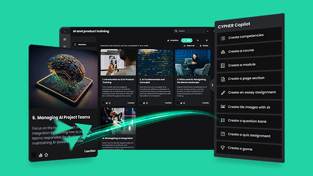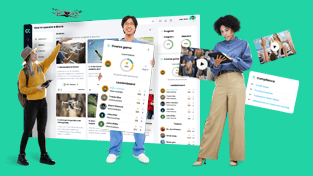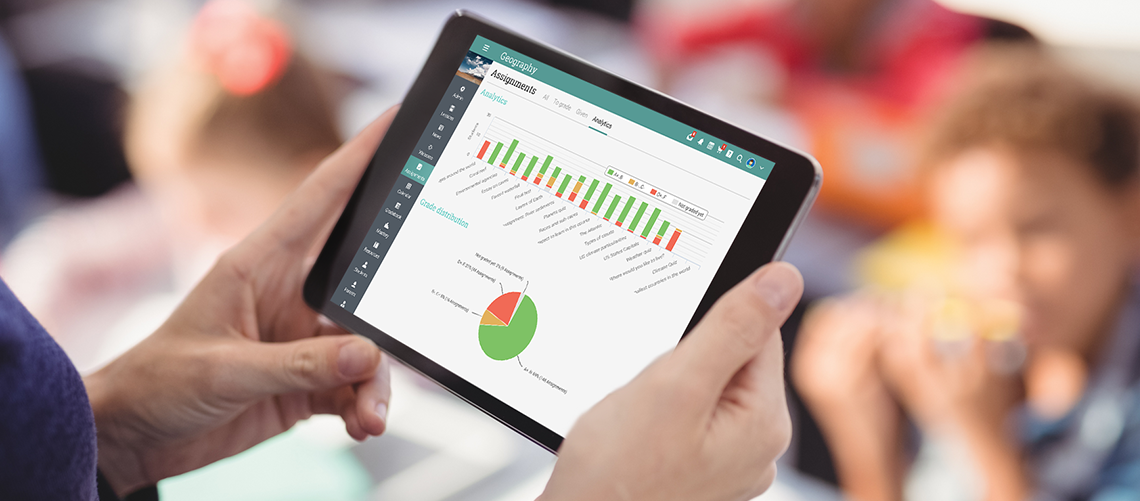As a teacher or school administrator, you need to stay informed about many class and student-related aspects. Doing this in an old-fashioned manner by talking to each student or manually checking attendance sheets and grades can be extremely time-consuming.
However, using a learning management system (LMS) allows you to stay updated on various school-related aspects with little effort. How is this possible? By running regular reports.
LMSs boast a variety of tools that automatically gather and process information. These platforms track various actions and events. Some examples include students enrolling in a new course, completed assignments, or class certificates. Whether you want to create grade charts or reports about class status or class completion, your learning platform can help you out.
Discover five of the most common and useful LMS reports your school LMS must have.
Why use LMS reports for your school?
There are a few good reasons why you could and should rely on reporting tools if your school is already using an LMS or is planning to adopt one. These are practical and user-friendly LMS features that will help you:
Save time and easily access information
Nowadays, edtech is more present than ever in daily teaching and grading activities, as it helps speed things up and streamline teachers’ work. Moreover, teachers can also use edtech to personalize education for students. All these can only lead to one result: improved efficiency.
By running reports on class attendance or test results, you get instant access to information that would otherwise take hours to collect. Just think about manually adding the results of each test in a spreadsheet vs. letting the LMS do this job for you.
Moreover, LMS reports provide you with data at a glance. You gain access to various report outputs, including tables and charts that are easy to view, understand and remember.
Make the best decisions based on data, not gut feelings
The purpose of evaluation in education isn’t only to help students grow by acquiring new knowledge. Students’ results also say a lot about a teacher’s ability to deliver content efficiently and help them grasp the essence of the class.
Therefore, by analyzing students’ grades via LMS reports, educational institutions can decide if a certain teacher needs to better adapt their class material or structure to students’ needs. Also, as a teacher, you can draw these conclusions yourself and constantly improve your teaching methods and materials to help students make the most of your classes.
What are the two main types of LMS reports?
LMS reports come in different forms and they provide a lot of insights. They usually fall into two main categories — built-in reports and custom reports.
Built-in reports
Built-in reports are those types of reports your LMS will offer by default. If you access the reporting tool area in your platform, you can check out the available built-in reports. You can simply generate these LMS reports with a few clicks. They can include data on class attendance, class completion, grades, lessons, and plenty more.
Custom reports
Unlike built-in reports, these reports need a bit of extra effort because, as their name suggests, these are customized, which means you have to define them. For this, you need to select the specific parameters you want to use.
For example, you can run a combined report to get the class attendance statistics for different groups of students or get both student grades and attendance stats. You can also get more comprehensive reports, for example, on the overall number of classes available in your platform, their type and the teachers responsible for each class.
The bottom line is that there are plenty of reports you can generate based on your needs.
5 Reports your school LMS must have
LMSs vary in design, features, accessibility, etc. However, when it comes to the reports they offer, these systems are more or less similar. There is a set of basic reports you should find in any LMS. Here are some of the most important ones:
-
Student reports
These reports can be as specific or comprehensive as you want. For example, if you’re an administrator, you can run a report that includes all the students in your institution, their names, year of study, the classes they attend, their enrolment date, and more.
Teachers can also gain access to different information about the students in their classes with the help of these reports. For example, they can see how many students they’ve got, when they completed an assignment and their missed assignments.
-
Class reports
Class reports are very useful both for teachers and administrators as they can provide information about:
- Enrolment: the students who are or have been enrolled in a class;
- Attendance: records on how many students attended a class;
- Missing work: assignments not yet submitted by students;
- Completion: the number of students who have successfully completed a class;
- Class status: current or former students and their class completion status;
- Compliance: classes that are necessary for compliance purposes and their status.
With this data, you can build a comprehensive image of student performance, their preferences and abilities, and the areas they need to improve. Also, you will know what actions are required on teachers’ behalf to ensure students enjoy a smooth learning experience especially in the remote or blended environment.
For example, if multiple students struggle to complete a particular class, you might want to change some of its contents. If a student has class attendance problems or fails to complete their assessments, it might be useful to schedule a 1:1 meeting to discuss and solve these issues.
Thus, LMS reports can help you spot common student problems and find the most appropriate solutions for absenteeism, missing work, or other challenges.
-
Assessment reports
LMSs not only enable you to minimize cheating in online assessments, but they also help save valuable time by automatically grading assignments. After students complete an assessment, you simply access the LMS to run a report and see how they performed.
Assessment reports offer a quick overview of how your students evolve based on their results. There’s no need to check each test or each user profile manually. All you need is included in one straightforward document you can download and save for later use.
These reports also enable you to get student progress statistics over time. You can include multiple test results in a single report to realize if your students are making headway.
Then, based on what the numbers show, you can adapt your classes accordingly and customize each student’s learning path by:
- Asking them to retake certain classes or tests;
- Giving them extra resources to study;
- Using adaptive learning to show relevant content based on each student’s level.
Read more: Is an LMS the best grading companion for teachers?
-
Group reports
Group reports are also useful, especially for administrators who need to understand their student demographics. An LMS allows you to create various student groups based on different criteria such as:
- The classes students enrolled in;
- Students’ age and year of study;
- The teacher who’s in charge of a class or group.
With the help of reporting features, you can easily see how many groups of students the platform has or how many members in each. You can also select the parameters you need for custom reports.
For instance, you can run a report on the students' age in each group to see which one predominates. Their location or other demographics such as age can also be included in group reports.
-
Organization reports
This is another report administrators can run, customize, and share with stakeholders. Within an LMS, organizations can represent schools in a district, the different departments of a school or university, or the groups within an educational institution. Every user can be associated with the correspondent organization.
Administrators can access each organization and run related reports. Organization reports include different data and statistics on classes, users, groups, and more. This information can easily be customized or filtered based on the existing requirements and necessities.
For example, an organization report can include the name and type of classes provided by each department. The duration of each class, the teachers in charge, and the number of students enrolled in each class can also be added to the report. All these insights can be used in larger reports that stakeholders require to make data-driven decisions.
Conclusion
LMSs facilitate growth for students and educators in many ways. Reports are just one of the main features that drive development and improvement with the help of in-depth, accurate data. Learning platforms provide an extensive array of reporting tools you can use to retrieve important insights about students and classes and improve your in-person or online teaching accordingly.







